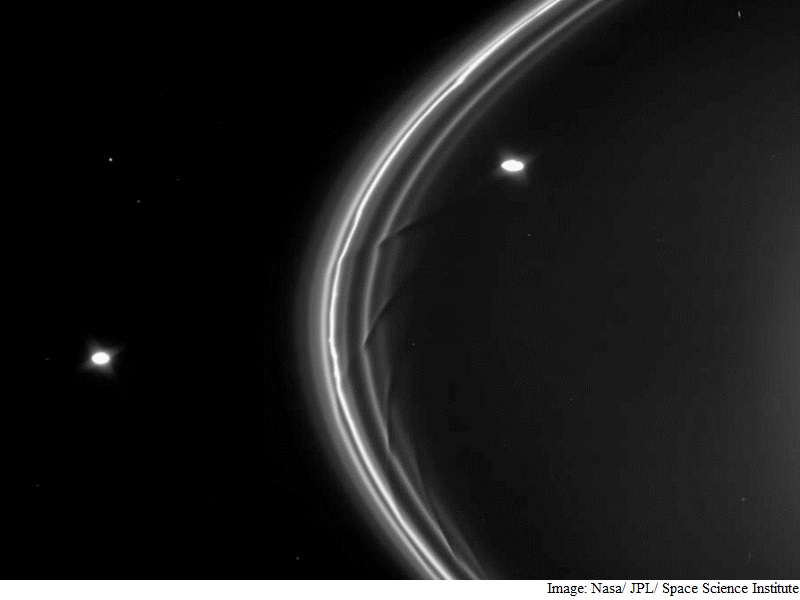- Home
- Science
- Science News
- Origin of Saturn's F Ring and Its Shepherd Satellites Revealed: Study
Origin of Saturn's F Ring and Its Shepherd Satellites Revealed: Study

According to the latest satellite formation theory, Saturn used to have ancient rings containing many more particles than they do today, and satellites formed from spreading and accretion of these particles.
During the final stage of satellite formation, multiple small satellites tend to form near the outer edge of the ring.
In their simulations using in part computer systems at the National Astronomical Observatory of Japan, professor Ohtsuki Keiji and student Hyodo Ryuki from Kobe University revealed that the F ring and its shepherd satellites formed as these small satellites with a dense core collided and partially disintegrated.
In other words, the system of the F ring and its shepherd satellites is a natural outcome of the formation process of Saturn's ring-satellite system.
"As plans are underway in and outside of Japan to explore the satellite system of Jupiter and the satellites of Mars, we will continue to unravel the origin of satellite systems, which is key to understanding the formation process of planetary systems," Ohtsuki said.
The F ring is very narrow with a width of only a few hundred km and has two shepherd satellites called Prometheus and Pandora, which orbit inside and outside the ring, respectively.
Although the Voyager and Cassini spacecraft later made detailed observations of the F ring and its shepherd satellites, their origin has not been clarified till now.
Saturn, which is the second largest planet in our solar system, is known to have multiple rings and satellites.
This new finding is expected to help elucidate the formation of satellite systems both within and outside our solar system.
The paper was published online in the journal Nature Geoscience.
For the latest tech news and reviews, follow Gadgets 360 on X, Facebook, WhatsApp, Threads and Google News. For the latest videos on gadgets and tech, subscribe to our YouTube channel. If you want to know everything about top influencers, follow our in-house Who'sThat360 on Instagram and YouTube.
Related Stories
- Samsung Galaxy Unpacked 2025
- ChatGPT
- Redmi Note 14 Pro+
- iPhone 16
- Apple Vision Pro
- Oneplus 12
- OnePlus Nord CE 3 Lite 5G
- iPhone 13
- Xiaomi 14 Pro
- Oppo Find N3
- Tecno Spark Go (2023)
- Realme V30
- Best Phones Under 25000
- Samsung Galaxy S24 Series
- Cryptocurrency
- iQoo 12
- Samsung Galaxy S24 Ultra
- Giottus
- Samsung Galaxy Z Flip 5
- Apple 'Scary Fast'
- Housefull 5
- GoPro Hero 12 Black Review
- Invincible Season 2
- JioGlass
- HD Ready TV
- Laptop Under 50000
- Smartwatch Under 10000
- Latest Mobile Phones
- Compare Phones
- Moto G15 Power
- Moto G15
- Realme 14x 5G
- Poco M7 Pro 5G
- Poco C75 5G
- Vivo Y300 (China)
- HMD Arc
- Lava Blaze Duo 5G
- Asus Zenbook S 14
- MacBook Pro 16-inch (M4 Max, 2024)
- Honor Pad V9
- Tecno Megapad 11
- Redmi Watch 5
- Huawei Watch Ultimate Design
- Sony 65 Inches Ultra HD (4K) LED Smart TV (KD-65X74L)
- TCL 55 Inches Ultra HD (4K) LED Smart TV (55C61B)
- Sony PlayStation 5 Pro
- Sony PlayStation 5 Slim Digital Edition
- Blue Star 1.5 Ton 3 Star Inverter Split AC (IC318DNUHC)
- Blue Star 1.5 Ton 3 Star Inverter Split AC (IA318VKU)
















